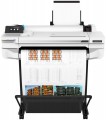Placement
-
Floor. Plotters designed for installation directly on the floor, on special stands; the availability of a stand for such a device is mandatory, because it carries various auxiliary equipment – particularly, a basket for completed prints. The floor models are predominantly advanced models, which are distinguished by their large weight and size. This option is convenient because the plotter does not require additional surfaces such as tables for installation. On the other hand, such a unit can create inconvenience in tight room where there is little free space on the floor. Also note that some floor models are not equipped with stands, they must be purchased separately.
-
Desktop. Plotters designed to be placed on a table, workbench, or other similar stand. This installation is good in constrained conditions, because it does not require floor space. On the other hand, it imposes some restrictions on weight and dimensions, which is why desktop plotters are usually designed for relatively small paper sizes - A2, less often A1 (see above).
Max resolution
The highest image resolution the plotter is capable of printing on paper. It is indicated by the number of dots per inch horizontally and vertically — for example, 1440x720.
The higher the resolution, the smoother the printed image will be as a result, the less noticeable individual dots will be on it (to the point that they cannot be seen at all with the naked eye). On the other hand, the ability to print in such resolutions affects the price of the plotter accordingly. In addition, do not forget that high-quality printing requires appropriate source materials — the quality of the print cannot be higher than the quality of the original image.
Note that in this case we are talking about the maximum resolution; usually in the settings it is possible to set more modest parameters.
Sheet printing time
Approximate time taken by the plotter to print one sheet.
This indicates for the paper size that the machine was originally designed for (see "Paper Size"). And it is approximate because it is usually given for optimal or almost optimal printing conditions: low quality and resolution, relatively simple images, etc. So the actual print time of the sheet may differ from the claimed one in one direction or another, depending on the operating parameters — starting from the mentioned quality and resolution to the type of media. However, according to the figures indicated in the specs, it is quite possible to evaluate different models and compare them with each other: the difference in the claimed time, usually, will proportionally correspond to the difference in the actual printing speed.
It is also worth noting that this time is usually indicated by the duration of the printing process itself — from the capture of the sheet by the feeder to the output of the completed print from the device. Interruptions inevitably occur between printing individual sheets, so that the total printing time is longer than the printing time of a sheet multiplied by the number of sheets. For example, a device with a time consumption of 36 sec per sheet theoretically should print about 100 sheets per hour (1 h = 3600 s, 3600/36 = 100), but in fact such a plotter usually produces about 70 – 75 sheets in this time.
Built-in memory
The amount of built-in memory provided in the design of the plotter.
Such memory is used to store various service data: print tasks, settings profiles, etc. Due to this, the plotter becomes more "independent": for example, many models allow you to continue printing even when the master PC is turned off.
We emphasize that in this case we are talking about solid-state flash memory, which is used mainly for "operational" service information. The capacity of such memory is relatively low, it is measured in megabytes; but in addition to it, the design may include a larger storage capacity — usually a traditional hard drive. For more information about it, see "Drive Capacity".
Main unit dimensions (WxDxH)
Dimensions of the main unit of the device. For desktop models (see "Placement") this is the total size of the entire plotter, it is a spec you need to focus on while choosing a model and evaluating a place for installation. For floor-standing devices, the dimensions are indicated here without taking into account the stand, so this parameter plays a minor role and can be useful mainly for storing or transporting the device in disassembled form.
Weight
The total weight of the plotter is usually listed without ink and paper. You should pay attention to this parameter foremost when choosing desktop models (see "Placement"): modern plotters are quite massive, which puts forward corresponding requirements for stands for them.
